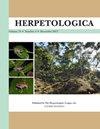Novel Allometric Estimators Improve Estimation Accuracy of Body Surface Area, Volume, and Surface Area-to-Volume Ratio in Lungless Salamanders (Urodela: Plethodontidae)
IF 1.1
3区 生物学
Q2 ZOOLOGY
引用次数: 0
Abstract
Abstract Body surface area and volume are both physiologically important traits in amphibians, as their ratio constrains transport rates for water and respiratory gases across the skin. This is especially true in the lungless salamanders (Urodela: Plethodontidae), whose lungless morphology restricts nearly all gas and water transport to the body surface. Due to methodological difficulties of measuring surface area and volume, estimation techniques are the most convenient way to produce usable phenotype scores. To this end, we used high-resolution computerized tomography (CT) scans of three plethodontid species varying in body size and shape to produce allometric regression models to estimate body surface area (SA), volume, and surface area-to-volume ratio (SA:V). We compared our model estimates to empirical measurements and established estimation methods employed in the Plethodontidae using linear models and Deming regressions. We found our model estimates are both accurate and generalizable across temperate plethodontid species. This method significantly improves SA estimation accuracy when compared to published allometric models. Our models are also significantly more accurate than SA or volume estimates following geometric measurements, although SA:V estimates are comparable between these techniques for most body sizes. We discuss the relative utility of different estimation methods for future research questions.新型异速估算器提高无肺蝾螈体表面积、体积和表面积体积比估算精度
在两栖动物中,体表面积和体积都是生理上重要的特征,因为它们的比例限制了水和呼吸气体通过皮肤的运输速率。这在无肺蝾螈(尾纲:多齿螈科)中尤其如此,它们无肺的形态限制了几乎所有气体和水的输送到体表。由于测量表面积和体积的方法困难,估计技术是产生可用表型评分最方便的方法。为此,我们使用高分辨率计算机断层扫描(CT)扫描了三种不同体型和体型的多齿兽,建立了异速生长回归模型来估计体表面积(SA)、体积和表面积与体积比(SA:V)。我们将我们的模型估计值与经验测量值进行了比较,并利用线性模型和Deming回归建立了齿齿科的估计方法。我们发现我们的模型估计在温带齿形动物物种中既准确又可推广。与已发表的异速生长模型相比,该方法显著提高了SA估计的精度。我们的模型也明显比几何测量后的SA或体积估计值更准确,尽管对于大多数体型,这些技术之间的SA:V估计值具有可比性。我们讨论了不同估计方法的相对效用,以解决未来的研究问题。
本文章由计算机程序翻译,如有差异,请以英文原文为准。
求助全文
约1分钟内获得全文
求助全文
来源期刊

Herpetologica
生物-动物学
CiteScore
4.60
自引率
0.00%
发文量
27
审稿时长
>12 weeks
期刊介绍:
Established in 1936, Herpetologica is a quarterly peer-reviewed journal serving herpetologists, biologists, ecologists, conservationists, researchers and the scientific community. The journal contains original research papers and essays about the biology of reptiles and amphibians, and covers many relevant topics including: behavior, conservation, ecology, genetics, morphology, physiology and taxonomy.
 求助内容:
求助内容: 应助结果提醒方式:
应助结果提醒方式:


